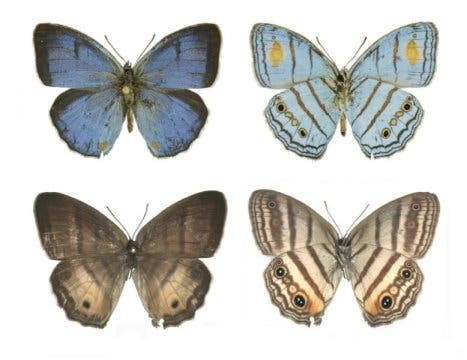Hey, anyone can make a mistake… even butterfly experts. A beautiful blue butterfly in the Amazon was first described and named in 1911. Recently, a brown butterfly was discovered and also named. However, it now turns out that these two butterflies are actually the same species!
The sunburst cerulean-satyr butterfly, Caeruleuptychia helios, was described when a researcher saw the bright blue butterflies. It was assumed that the females looked the same. When a rarer brown butterfly was described recently, it didn’t look like any other species and was named Magneuptychia keltoumae, in a completely different genus.

Recently, researchers wanting to have an idea of butterfly biodiversity in the neotropics took so-called DNA barcodes of hundreds of butterfly species. DNA barcodes are parts of the genome that are informative and unique in identifying species. Each one should, therefore, be different from any other. The researchers’ goal was to have an idea of the biodiversity in the area. It is especially important to survey biodiversity now as it is being lost at an alarming rate — largely due to human activity.
“These findings are extremely valuable at a time when the biodiversity of the Neotropics is threatened since it will be impossible to recognize and document the region’s unique elements of biodiversity after they are gone,” said said Shinichi Nakahara, a researcher at the Florida Museum of Natural History’s McGuire Center for Lepidoptera and Biodiversity at the University of Florida.
The barcodes of Caeruleuptychia helios and Magneuptychia keltoumae turned out to exactly the same! The blue butterfly is the male and the brown one is the female. Now both butterflies are called Caeruleuptychia helios. The butterflies in their group usually look pretty similar, which is why no one had suspected that they could be the same butterfly. The researchers were surprised by their unexpected finding. They learned that butterflies from their group can have males and females that look very different from each other, so extreme sexual dimorphism. Using this information, the researchers were able to recognize the males and females from two other species from the same group. As it turns out, the butterflies from this group are actually among the most sexually dimorphic in the world.
A lesson to be learned from this finding is that DNA analysis and appearance together can give you a much better idea of a species than either alone.
Journal reference: Shinichi Nakahara, Thamara Zacca, Blanca Huertas, Andrew F. E. Neild, Jason P. W. Hall, Gerardo Lamas, Lauren A. Holian, Marianne Espeland, Keith R. Willmott. Remarkable sexual dimorphism, rarity and cryptic species: a revision of the ‘aegrota species group’ of the Neotropical butterfly genus CaeruleuptychiaForster, 1964 with the description of three new species (Lepidoptera, Nymphalidae, Satyrinae). Insect Systematics & Evolution, 2017; DOI: 10.1163/1876312X-00002167
Was this helpful?



